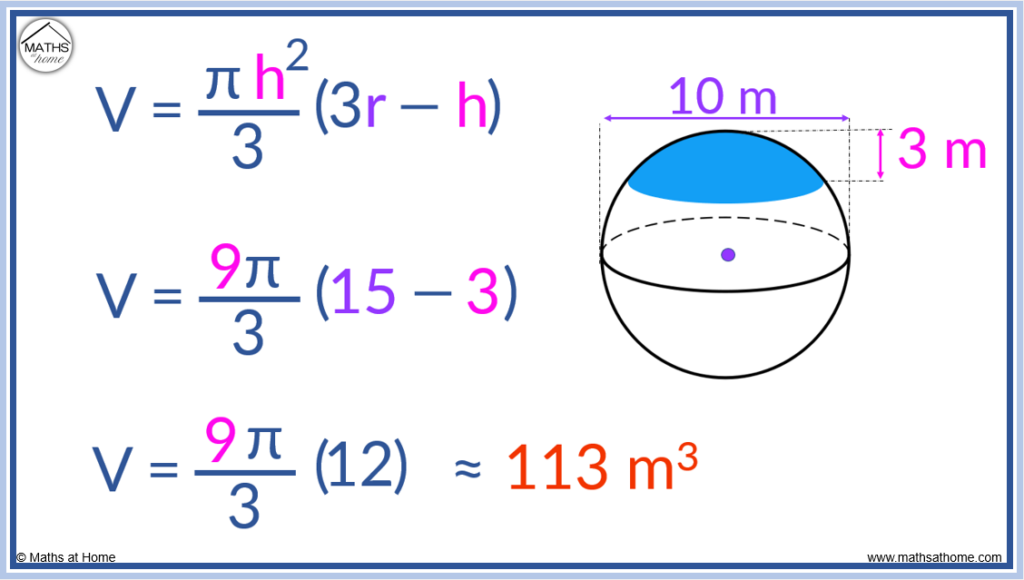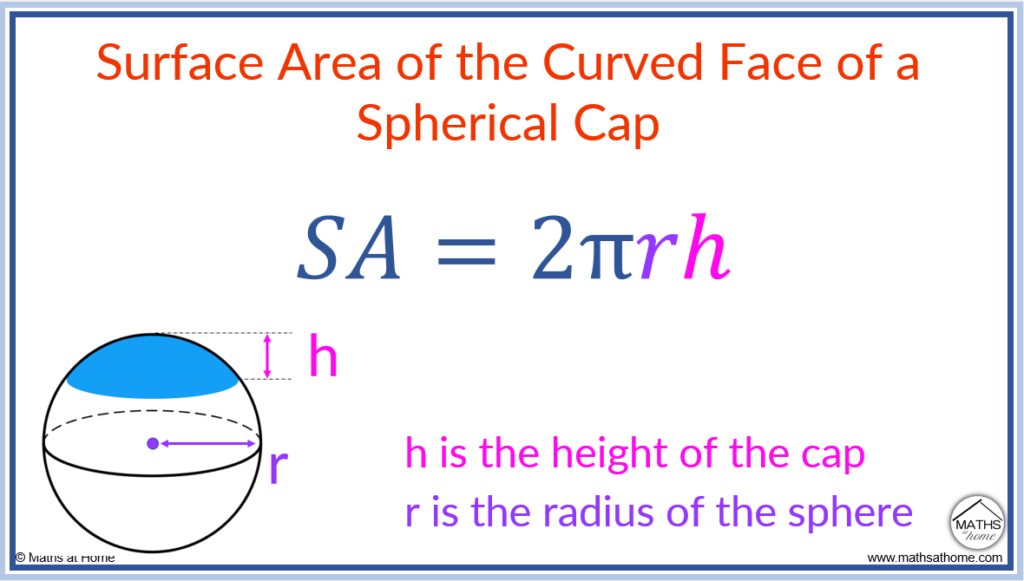Video Lesson: Calculating the Volume of a Spherical Cap
Volume and Surface Area of a Spherical Cap Calculator
The calculator below calculates the volume and surface area of a spherical cap.
Simply enter the following values:
- ‘h’ is the height of the spherical cap
- ‘r’ is the radius of the sphere
- ‘a’ is the radius of the base of the spherical cap
What is a Spherical Cap?
A spherical cap is a region formed by making any plane cut through a sphere. It has a curved spherical top face and a circular face on its base. The resulting shape looks like a cap which is on the top or side of a sphere.
Examples of spherical caps are shown in blue the image below.
Spherical caps are made whenever the side part of a sphere is cut off with a straight line.

A spherical cap can be described using the values of ‘a’, ‘h’ and ‘r’.
- ‘a’ is the radius of the circular base of the spherical cap
- ‘h’ is the height of the cap
- ‘r’ is the radius of the sphere

A hemisphere is an example of a circular cap in which the plane cut through the sphere passes exactly through the centre of the circle.

Formula to Find the Volume of a Spherical Cap
The volume of a spherical cap in terms of ‘r’ and ‘h’ is V = (πh2/3)(3r-h), where r is the radius of the sphere and h is the height of the spherical cap.
The volume of a spherical cap in terms of ‘a’ and ‘h’ is V =(πh/6)(3a2+h2), where a is the radius of the base of the cap and h is the height of the cap.
‘a’ is the radius of the circular base of the spherical cap
‘h’ is the height of the cap
‘r’ is the radius of the sphere


If the both the height of the cap, ‘h’ and the radius of the sphere, ‘r’ are known, then use the formula .
If both the radius of the base of the cap, ‘a’ and the height of the cap, ‘h’ are known, then use the formula .
How to Find the Volume of a Spherical Cap
To find the volume of a spherical cap, substitute the values of the sphere radius ‘r’, and height of the spherical cap ‘h’, into the formula V = (πh2/3)(3r-h).
For example, calculate the volume of the spherical cap with a sphere diameter of 10m and a spherical cap height of 3m.
If the diameter of the sphere is 10m, then the radius is half of this.
The values of:
‘r’ = 5m
‘h’ = 3m
are substituted into .

becomes
.
Evaluating this further, we obtain , which simplifies to
.
The volume is approximately 113m3.
For example, calculate the volume of the spherical cap with sphere radius 3cm and spherical cap height of 2cm.
The values of:
- ‘r’ = 3
- ‘h’ = 2
are substituted into .

becomes
.
Evaluating this, we obtain which is approximately 29.3 cm3.
For example, calculate the volume of the spherical cap with base radius 5cm and a height of 2cm.
The values of:
- ‘a’ = 5
- ‘h’ = 2
are substituted into the formula .

becomes
.
This simplifies to which is approximately 82.7 cm3.
Derivation of the Formula for the Volume of a Spherical Cap
The formula for the volume of a spherical cap can be derived by integrating π𝑥2 with respect to y between the limits of r and r-h.
The full derivation of the formula from integrals is shown below.
Step 1. Form the integral equation
The centre of the sphere is taken as the origin point, with the y-axis vertically and the x-axis horizontally.
The volume of the spherical cap can be found by finding the sum of the circular discs as shown in red below. Each circular disc has a different radius, which will be of length x.
The area of each circle is therefore πx2.
We want to sum the areas of the circles in the y direction. Therefore the volume is found as the integral of .
In the y-direction, the top of the spherical cap is at a y value of r and the base of the cap is at a y value of r-h.
Therefore the volume is given by the integral .

In order to be able to perform the integration, we need to find x in terms of y.
From Pythagoras’ theorem, the radius of the circle is connected to x and y by the equation .
Rearranging for x, we obtain .
Substituting into
, we obtain
.
This simplifies to .
Step 2. Integrate and simplify
We now integrate to obtain
.
Substituting the limits of integration, we obtain .
This simplifies to following the algebraic steps shown below.

Surface Area of a Spherical Cap
The curved surface area of a spherical cap is given by Area = 2πrh where r is the radius of the sphere and h is the height of the cap. Alternatively, the curved surface area is also given by Area = π(a2+h2), where a is the radius of the circle on the base of the cap and h is the height of the cap.


The base area of the spherical cap is πa2 and the total surface area of a spherical cap can be given by SA=2πrh+πa2 or SA=π(2a2+h2).


For example, calculate the total surface area of a spherical cap with a height of 4 cm and a cap base radius of 5 cm.
We substitute:
- ‘a’ = 5
- ‘h’= 4
Into the equation to obtain
.
This can be evaluated to which is approximately 207 cm2.
For example, calculate the outer surface area of a spherical cap with a height of 6 cm and a spherical radius of 12 cm.
We substitute:
- ‘h’ = 6
- ‘r’= 12
Into the equation to obtain
.
This can be evaluated as which is approximately 452 cm2.
